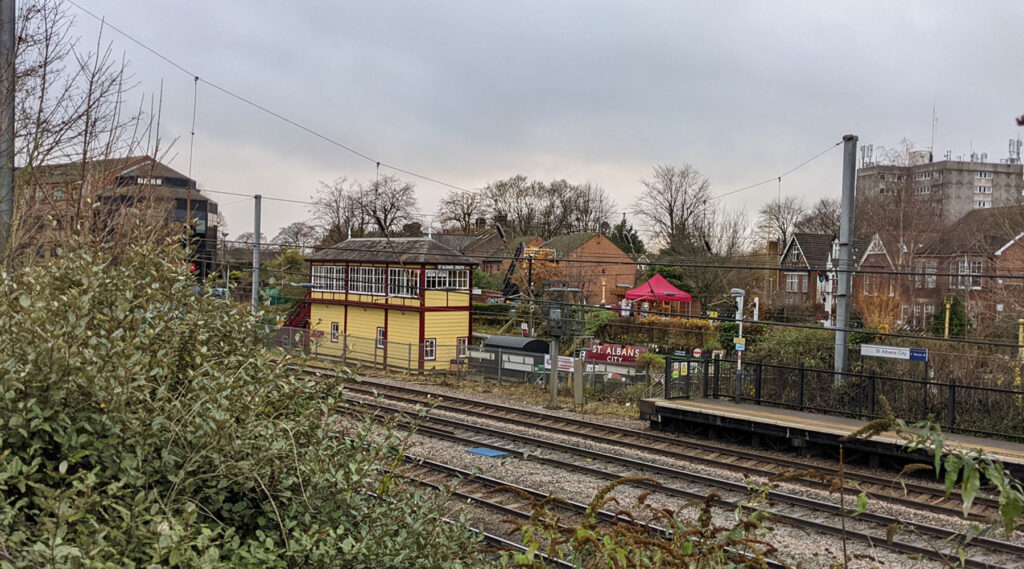Next to St Albans City railway station is a brightly painted wooden building – a restored signal box that’s now occasionally open to the public.
The signal box is the second on this location, and came into use in June 1892 as part of the Midland Railway into St Pancras station, and is classified by members of the Signalling Record Society as a Midland Railway ‘Type 2A’. It was assembled from pre-fabricated parts made in Derby and served as a signal box controlling the southern side of St Albans City station right up to the end of 1979, and fully closed in early 1980. After it closed, other than decay, nothing much happened until the turn of the Millenium, when local residents asked Network Rail to get rid of the increasingly shabby building as it was an eyesore.
But, Network Rail couldn’t — just before it closed, the signal box had been granted Grade II heritage protection. An offer from Network Rail to give it away so it could be moved somewhere else was accepted until it turned out that the building was by then in such a poor state that it couldn’t really be moved.
Fortunately, an alternative idea came along – preserve the box in situ, and by remarkable good fortune, a disused railway siding next to the signal box gave enough width between the live railway and the signal box to allow it to be safely accessed by non-railway personnel.
So, in 2002, a group was set up to save and restore the signal box, and next year marks its 20th anniversary.
After securing a peppercorn rent lease, and years of restoration work, it opened to the public in for a preview in 2006 and a formal opening in 2009. Thanks to a lot of donations of railway heritage over the past couple of decades, you now have so much more than just a signal box, but a whole display of railway signalling in the garden next to it.
An appetizer for the main box, is a tour around the garden by volunteers who explain how and why lots of the signalling worked, and was later supplanted by ever better systems. From the classic semaphores to the modern lights, and most of it is working. You will be able to play at being a signal operator pulling levers and seeing how signals move, and how the interlock prevents you from pulling the wrong levers in the wrong order.
Something that needs to be pointed out is a self-service single track running key token catcher – normally handed to the train driver, but here, on a pole for self-service grabbing.
Much more obvious is the model railway running along one side, and running along the trackside are a load of heritage signs from the railways. Some are on loan, one large sign appeared one day after being left over the fence. Some may have been “borrowed” when the signal box was decommissioned and mysteriously reappeared, arriving in unmarked packages.
Do be a big child and ring the bell that used to tell station staff what platform a train was arriving at, as modern trains rush past or slow down to arrive at St Albans City station.
Down at the signal box, and here’s something different. Signal boxes are two-story buildings as the levers are upstairs, but the massive interlocking machine — the mechanical computer that controlled how the signals worked — would be in the ground floor. Here, the interlocking machine is missing, so they’ve turned the ground floor into a museum, and it’s a wonderfully evocative space filled with, well, clutter, but clutter is good.
Here’s a load of oil lamps, over there are old electromechanical switches, here’s some old signs and posters, over there a glass case of collectables. A signal plan from the Waterloo & City line has somehow made its way up to St Albans. A model steam train turns out to be carved from a piece of coal. At least, they think it is.
Upstairs, is the classic signal box layout with levers and bells and they’ve wired up a simulation of the signals to show off what to do to let trains come through the station.
There’s so much more to see here than just a signal box and a solitary room filled with levers thanks to the museum downstairs and the garden full of working signals and levers. And the model railway of course.
It’s quite a wonderful place to visit for anyone as the volunteer talks are geared to anyone from the “this looks interesting, what is it” to the retired experts who occasionally turn up.
Unsurprisingly, the restoration picked up a National Railway Heritage Award in 2010.
Next year marks the 20th anniversary of the team of volunteers who came together to save a signal box, so what better year to visit? It’s open roughly monthly, and currently, the known open dates are Sundays 9th January, 12th February and 12th March 2022. Keep an eye on their website for more dates later in their anniversary year.
It’s free to visit with donations appreciated.
The signal box is just a few minutes walk from St Albans City station. A tip if travelling from London, although TfL’s contactless payments are accepted, it may be cheaper to buy a ticket to St Albans City from wherever your travelcard zone expires. For me, this meant I only needed a return from Mill Hill Broadway (zone 4), which is much cheaper.

























Looks like a really interesting visit, unfortunately a bit of a long trip for me. Thanks for the thorough report Ian.
That “model carved from coal.”
They’re produced by a company called Welsh Crafts. Sadly, I can’t post a link here.
I believe they’re made by pressing coal dust mixed with something to set it, into a mould.